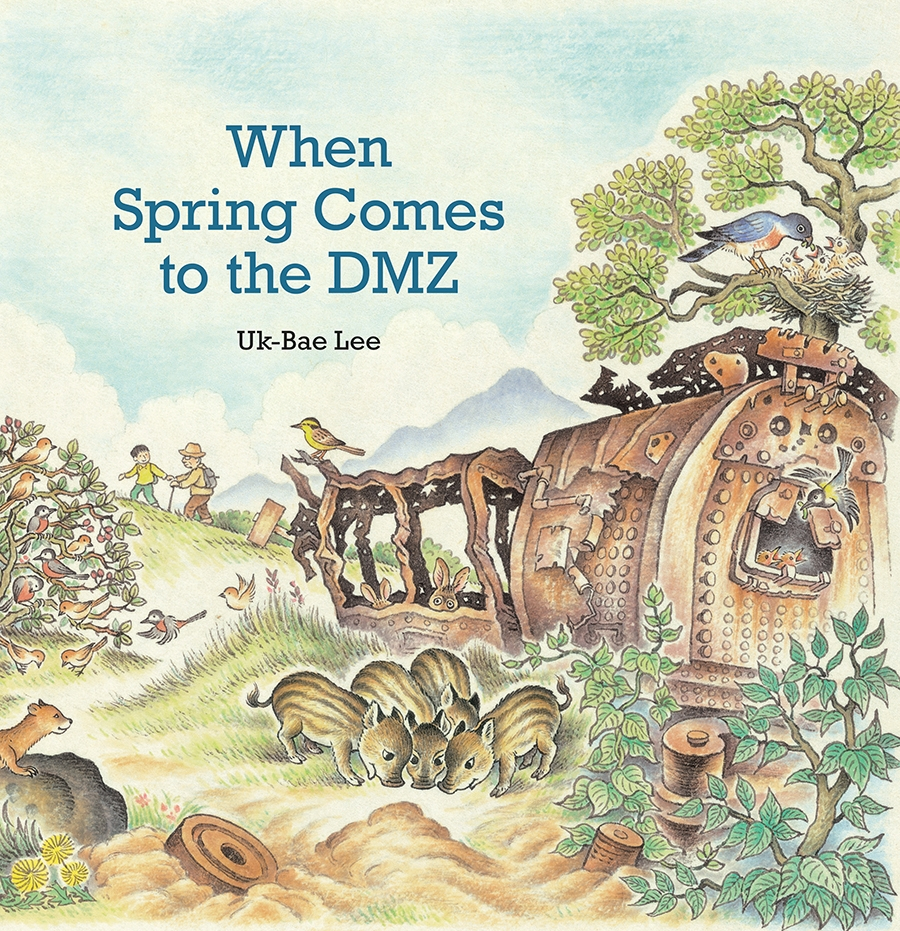
1. Bibliography
Lee, Uk-Bae. 2019. When Spring Comes to the DMZ. Walden, NY: Plough Publishing House. ISBN 978-0-87486-972-9
2. Plot Summary
In When Spring Comes to the DMZ, one boy’s grandfather—living in South Korea—goes to the observatory at the edge of the DMZ (also known as the “demilitarized zone,” a razor wire barrier that was put in place in 1954, separating North Korea from South Korea), peering at the wildlife thriving within its razor wire walls and at the armies manning the fence without. The boy and his grandfather go to the observatory each season, longing for the tightly locked gates to open and to see long-lost family members that are still trapped on the North Korean side of the divide. The final pages explain the DMZ, the Korean divide, and Uk-Bae Lee’s (and many other Koreans’) hope for the future.
3. Critical Analysis
Uk-Bae Lee’s illustrations carry a powerfully poignant message starting with the end papers in the very beginning of the book. There’s a map of the world, all in the same whitish hue except for a jagged red scar running through the middle of the Korean Peninsula. Immediately, Lee’s illustrations draw attention to that mottled area. Lee’s clever drawings don’t stop with the end pages, though. The title page includes a picture of the DMZ lookout glasses through which readers will “view” the DMZ wilderness on the next page spread with the grandfather, searching the far end of the razor wire barrier to try to catch a glimpse of what lies beyond.
Later spreads show peaceful animals unaffected by the barrier between North and South Korea, free to roam where they choose, while the soldiers that guard the border are—ironically—exhausted and locked out. The final spread of the story, when the grandfather flings open the tightly locked gates of the DMZ and joyfully reunites with lost loved ones from other side, packs a powerful punch. This is the only part of the story that isn’t describing what Grandfather is doing and seeing through his lookout glasses. Instead, it describes what he wants to do. The joyous family reunion that Grandfather wants so much is not yet a reality, but the beautifully imagined scene that Lee has drawn, uniting two aged brothers that haven’t seen each other in over 50 years, is so touching that readers will long for an end to the DMZ just like Grandfather. The final end pages reveal that the jagged red scar running through the middle of the Korean Peninsula has vanished. Again, the removal of the DMZ is not yet a reality, but a DMZ-less world is so appealing that it invites readers to want it too.
This picture book also offers something unique to picture book readers because it isn’t a historical story about a South Korean tragedy of long ago. No, this is a tragedy that is taking place in real time. The boy in the story is not a relic of the past but a modern 21st century kid, going on a seasonal outing with his grandfather, making him relatable to children across the globe who are reading his story. Still, while the divide is a heavy topic, Lee navigates When Spring Comes to the DMZ with grace, offering an ending that will leave children sad but hopeful. A book that allows children to understand a current global event affecting thousands of Koreans while inspiring empathy, When Spring Comes to the DMZ is a must-have picture book.
4. Rewards and Review Excerpts
Mildred L. Batchelder Award, 2020, Honor
Kirkus Best Picture Books, 2019
From Kirkus Review:“The cupboard is nearly bare of children’s books about the DMZ, making this an excellent introduction to the crises on the Korean Peninsula as well as a great choice for social justice collections, peace promoters, and animal lovers.”
From Booklist: “Highly detailed illustrations in watercolor and pencil capture the softness of Grandfathers heart and the exuberance of wildlife that grows without bounds. Back matter provides a brief explanation of the Korean War and the pain of the separated populations with eerie timeliness.”
5. Connections
Create a display of antiwar books for an elementary-age audience, such as the following selections:
- Winter, Jeanette. The Librarian of Basra: A True Story from Iraq. ISBN 9780152054458
- Mochizuki, Ken, and Dom Lee (illustrator). Passage to Freedom: The Sugihara Story. ISBN 9781584301578
- Coerr, Elizabeth. Sadako and the Thousand Paper Cranes. ISBN 9780698118027
- Long, Michael L., and Carlos Vélez (illustrator). Three Lines in a Circle: The Exciting Life of the Peace Symbol. ISBN 9781646981960
Create a display of When Spring Comes to the DMZ and other children’s books set in South Korea, such as the following selections:
- Cho, Tina. The Ocean Calls. ISBN 9781984814869
- Kim, So-un. Three Korean Fairy Tales. ISBN 9780804852272
- Park, Linda Sue. A Single Shard. ISBN 9780547534268
- Oh, Ellen. Finding Junie Kim. ISBN 9780062987983
- Cheung, Hyechong, and Prodeepta Das. K is for Korea. ISBN 9781845077891
- Lee, JiHyeon. Pool. ISBN 9781452142944